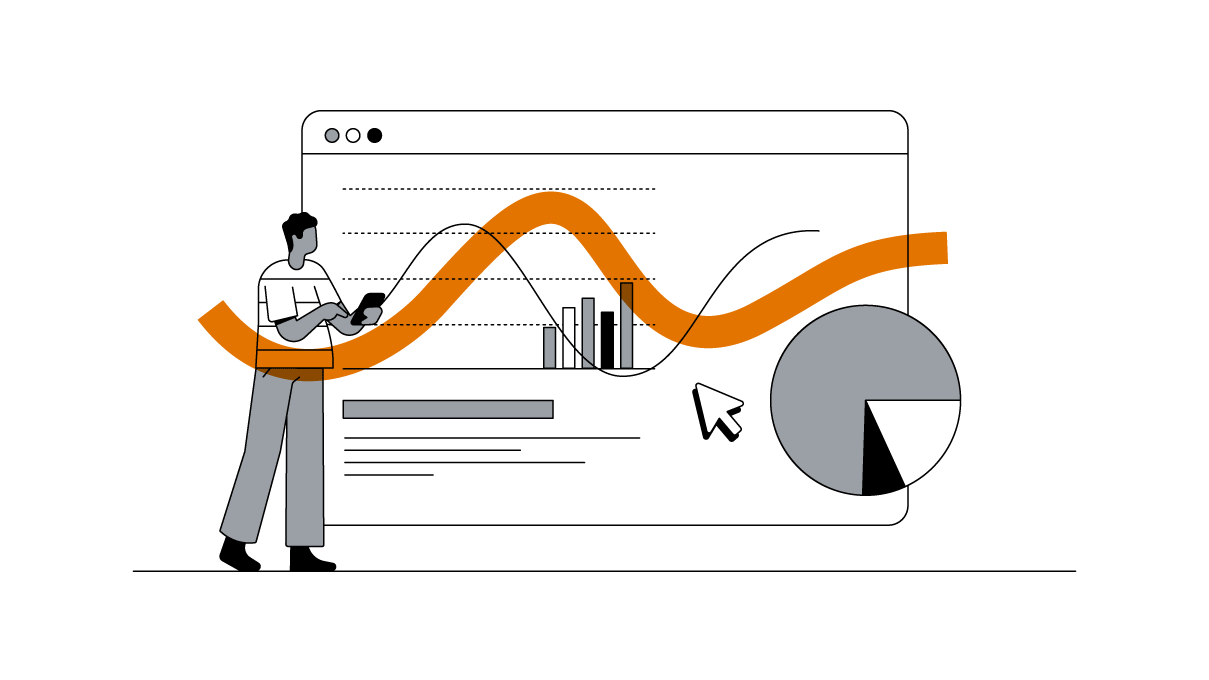One of the biggest challenges facing marketers is obtaining brand-specific intelligence without breaking the bank or waiting for results from a customized study. Luckily, the insights gleaned from search query data can answer many of the common questions marketers have about their competitors. What are they doing in the marketplace? How are they perceived? How do they stack up against your brand? By helping you get these answers quickly and easily, search data can help you validate existing marketing strategies or discover entirely new opportunities.
Getting the inside scoop on competitors—or even your own brand—isn't always easy. One of the biggest challenges marketers face is obtaining brand-specific intelligence without breaking the bank or sitting idly while waiting for results from a customized study.
Luckily, search query data can be used to answer many of the common questions marketers ask about the competitive landscape. What are other brands doing in the marketplace? How do people perceive them? What do they associate them with? And how do those perceptions stack up against what people think about my brand? While standard third-party research tools, custom research and internet fact-finding can address some of these questions, they just aren't enough. Every second and every penny counts, and there are faster and more economical ways to learn about competitors and opportunities.
In this Search Insights series, we've explored how to use search data broadly as a useful brand planning tool that can tap into cultural trends and category insights. Here, we'll show how search data can be used to learn very specific things about a brand, its competitors and the marketplace as a whole.
A snapshot of the company we keep
Over one billion search queries are made every single day, representing a massive pool of consumer expressions free from the biases we often get in consumer focus groups or opt-in surveys. These queries are an invaluable resource for learning about the competitive landscape from the consumer's perspective.
The bubble chart below gives a snapshot of the competitive search landscape for some top U.S. retailers for 2013. The size of each bubble reflects the relative volume of searches, and the proximity of bubbles reflects the likelihood that brands are co-searched, or searched within the same session. Together they present a reflection of the share of search for each brand and how the brands are associated with one another.
Search Share and Brand Association Map
United States, Shopping Category, 2013
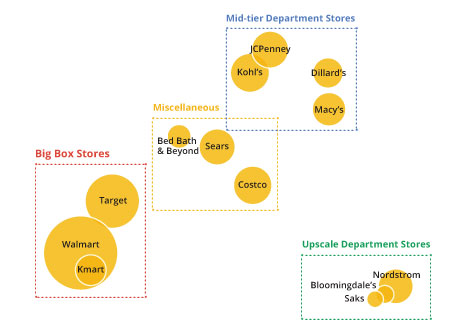
Source: Google Trends for Marketers
We see that Walmart leads in search volume (thanks largely to the chain’s size, scale, and broadly established geographic reach), while retailers like Kmart and Saks have a smaller share of the searching. There's more we can learn about the competitive landscape from this data, though. Bubbles that overlap (like JCPenney and Kohl's or Walmart and Kmart) indicate that customers frequently search for the two retailers together, perhaps comparing their product offerings or prices.
We also see that the upscale department stores are located far away from other retailers, suggesting that their consumers are in a different target group or have a different mindset while searching online than do customers of, say, Sears, Costco or Bed Bath & Beyond.
With a better understanding of what consideration sets they fall into, brands can better focus their marketing efforts. They might attempt to grow their "bubble" (their share of searches) or differentiate themselves from the stiffest competition.
Comparing competitive lifts during peak periods
Looking at search data over time also confirms that these retailers have their strongest season from Black Friday through New Year's Day. During that period, search interest in terms such as "coupons," "deals," "discounts" and "gift ideas" also spikes. While this may seem obvious, search data can also show the relative strength of brands during that period. For example, while Walmart may have shown the greatest relative volume of searches, Kohl's shows much stronger lift during the holidays, and Target has really broken from the pack. Analyzing search data is a good way for these brands to better understand how well they respond to both intrinsic holiday demand and demand they generate from their other media efforts.
Growth Over Time For Retailer Topics Compared With Shopping Category Growth
United States, Shopping Category, January 2010 to December 2013
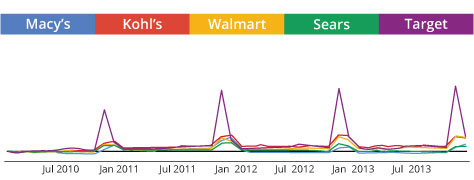
Graph shows the change over time as a percentage of growth with respect to the first date on the graph (January 2010).
Source: Google Trends for Marketers
What the customer thinks
By looking deeper into the search data, we can also find additional qualitative information about how brands are perceived by consumers. You'll note that below, for example, Kohl's is highly associated with "discounts" compared even with other big discount retailers like Walmart and Target.
Brand Interest Share for "Discount"
United States, Shopping Category, 2013
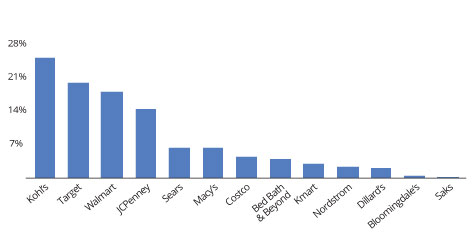
Each bar in the chart indicates the share of that brand searched with the word "discount" out of all the searches of any of the brands with "discount."
Source: Google Trends for Marketers
By contrast, when we zoom in on "family"-associated searches, Walmart takes the lead.
Brand Interest Share for "Family"
United States, Shopping Category, 2013

Each bar in the chart indicates the share of that brand's searched with the word "family" out of all the searches of any of the brands with "family."
Source: Google Trends for Marketers
Using these insights, brands can strategically plan where and how they want to compete with other brands in their industry. Walmart's strong association with family in the minds of consumers may open up an opportunity for another brand to win some consideration through deliberate creative and targeted media spend. A brand like Dillard's, on the other hand, may note that its competitors outperform it when it comes to searches for discounts and may make strategic ad buys to close the gap.
Facing off with the competition
Search query data can be used to compare brands head-to-head, as well. If we look at the share of search volume as it relates to how brands are co-searched with various descriptors or themes (attributes), consumer perceptions and interests emerge. This data can be used by a brand to find messaging or positioning opportunities to pursue or to monitor the progress of initiatives already undertaken.
According to our original bubble chart, JCPenney and Kohl's show strong search alignment—that is, a lot of co-searching occurs for those brands. In fact, there are indeed many overlapping searches across the same keywords including "discount," "credit card" and "hours." However, Kohl's consistently shows a greater share of searches across almost all the chosen keyword categories compared to JCPenney. We can see that it's only in some of the lower share of voice searches that JCPenney leads such as "jeans" and "fashion."
Attribute Interest Share for "JCPenney" vs. "Kohl's"
United States, Shopping Category, 2013
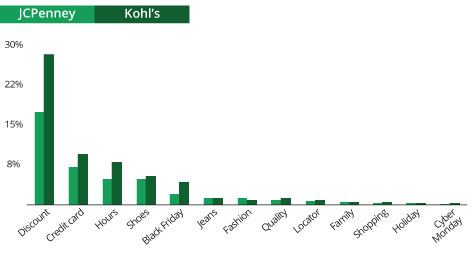
Each bar in the chart indicates the share of that attribute searched with the selected brands. Sum of bars=100%.
Source: Google Trends for Marketers
Going even deeper into top search categories
Let's take it further. Rather than selecting the search topics we want to explore, can we see which naturally rise to the top for JCPenney and Kohl's? And do those topics differ? The AdWords Keyword Planner reveals the top co-searched topics (keyword categories) for each of these brands. We can see that while both received a huge number of coupon-related searches in the last quarter of 2013, people often searched for JCPenney along with electronics topics, or, to a smaller degree, with keywords such as "outlets," "portrait" and "credit card." For Kohl's, search demand for coupons is the lion's share, but outside of that, there's a blend of categories relating to online shopping and apparel topics (including "clothing online" and "Kohl's shoes").
Keyword Categories - JCPenney
United States, Shopping Category, Average Monthly Searches Q4 2013
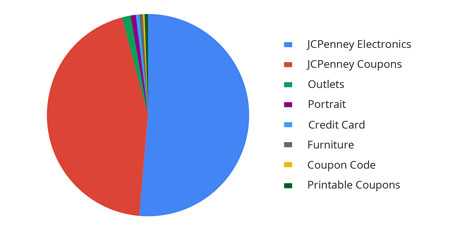
Source: Google AdWords Keyword Planner Tool
Keyword Categories - Kohl's
United States, Shopping Category, Average Monthly Searches Q4 2013
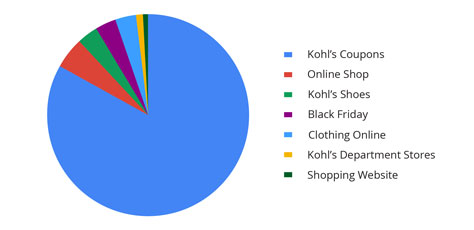
Source: Google AdWords Keyword Planner Tool
Such data can help a brand identify current areas of growth that might merit additional investment (for example, Kohl's and e-commerce opportunities, with a possible focus on shoes), and it can also highlight areas of potential expansion according to competitors' strengths (for example, JCPenney in electronics).
Take in the competitive landscape
As we've seen, search data provides a window into your brand's world. And it's a window with many views. Looking one way, you can see where your brand sits relative to your competition (in terms of share of search, brand alignment and so on). In another view, you can see how your brand is perceived by consumers' the categories, attributes and themes they associate it with and how those perceptions differentiate you from your key competitors. What you find can validate your existing marketing strategies or help you discover entirely new opportunities. The best part: speed. You can look through this window as you have your morning coffee. What will you see today?
This is the fourth article in a series on search insights. Check out the previous articles to learn why search is a brand planning power tool, how to tap into cultural moments and movements and how to examine category insights.

